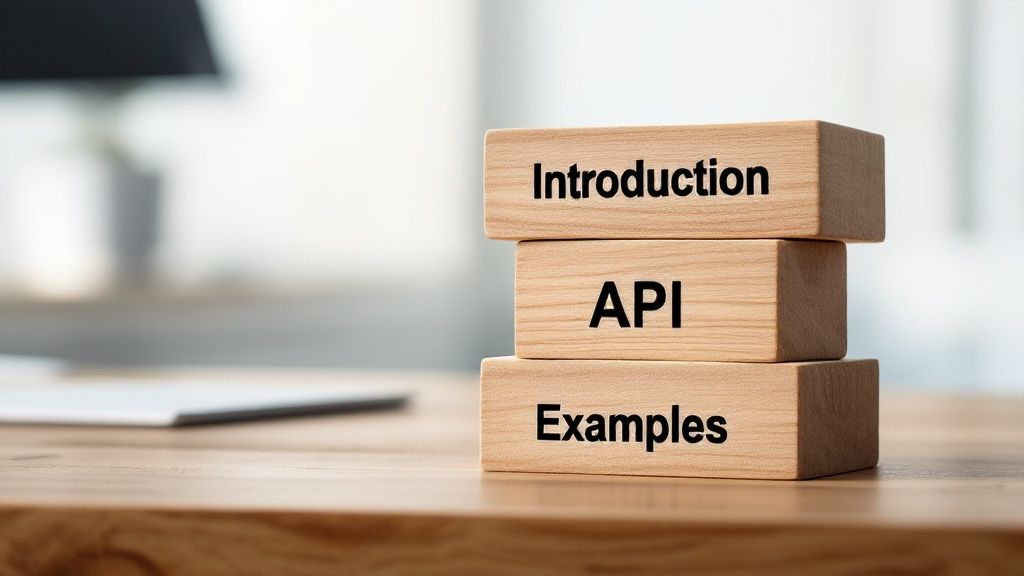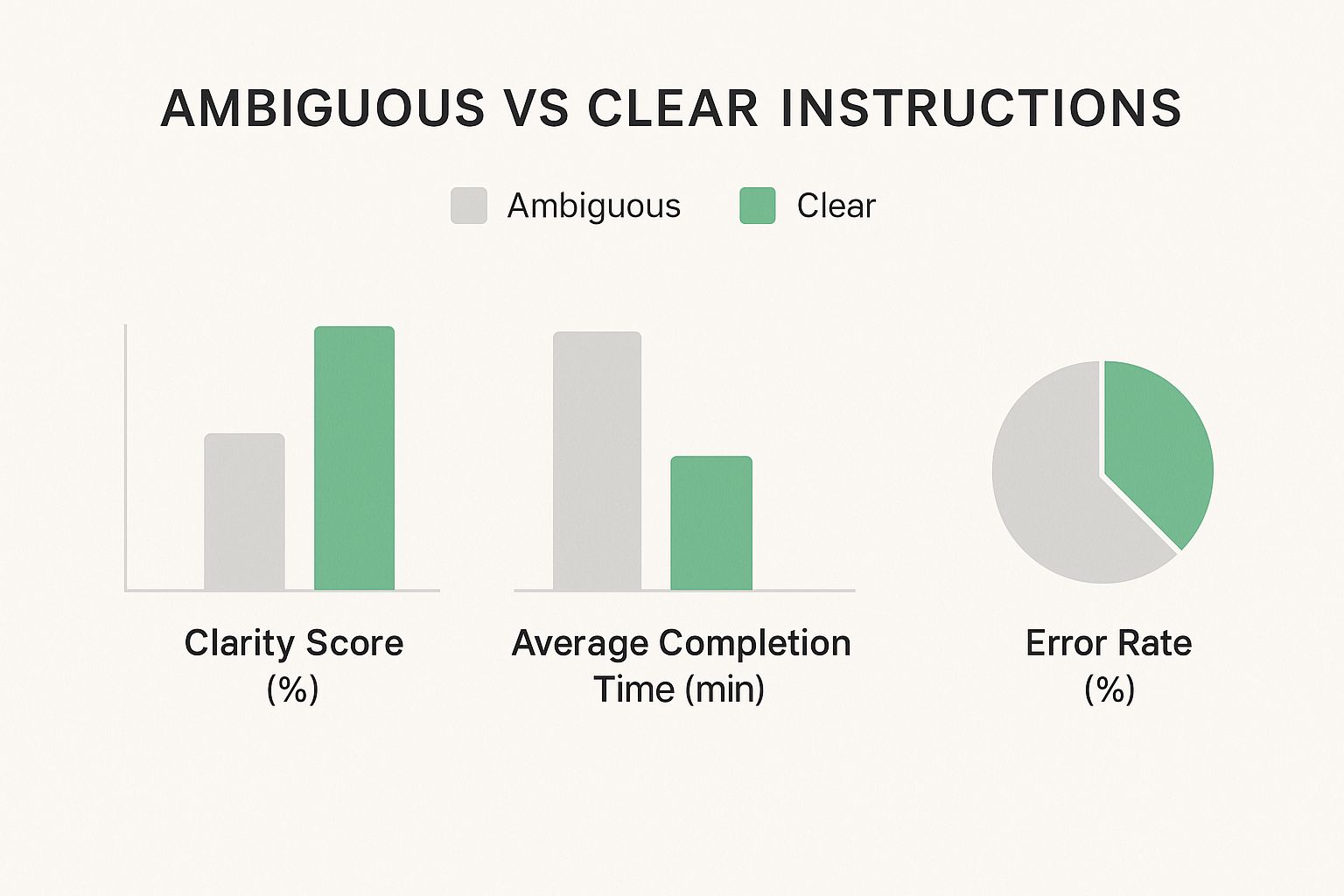Learn how to write a documentation that is clear, effective, and user-friendly. Our expert guide helps you master writing a documentation with ease.
Writing documentation is about so much more than just explaining features. It’s a strategic game plan built around who your users are, what they need to do, and the business goals you’re trying to hit.
The whole process starts by nailing down who you’re writing for and what you want them to achieve. Get this right, and you create content that’s genuinely useful. Skip it, and you’re just wasting effort on docs nobody will read.
Before you type a single word, the most important work has already begun. Seriously. The success of any documentation—whether it’s a beast of an API reference or a simple user guide—comes down to the quality of the initial planning.
Jumping straight into writing without a clear strategy is like trying to build a house without a blueprint. Sure, you might end up with four walls and a roof, but it’s not going to be a place anyone wants to live. This upfront thinking is what separates helpful, intuitive guides from those confusing walls of text that just send your support ticket count through the roof.
Everything hinges on two big questions: Who is this for? and What is its purpose? Get these wrong, and you’ll end up with documentation that’s technically accurate but completely misses the mark.
Your first job is to get way more specific than “our users.” You need to know exactly who is going to be reading your content.
Are you writing for a senior developer who just wants to see concise API endpoint descriptions and code samples, stat? Or is it for a non-technical marketing manager who needs a detailed, step-by-step walkthrough for setting up their first campaign? The language, tone, and depth you’d use for these two people are worlds apart.
A proper audience analysis digs into what your users actually need. Here’s what to focus on:
Once you know your audience, you have to define what a “win” looks like. Your documentation needs to serve a specific, measurable purpose that ties directly back to bigger business goals. A fuzzy objective like “to help users” is useless because you can’t measure it.
Get concrete. Is the goal to slash support tickets for a specific feature by 30%? Maybe you want to cut new user onboarding time from five days down to just one. Or perhaps the main objective is to boost API adoption among third-party developers.
These kinds of clear targets give you a North Star for every decision you make. For a deeper look at this, check out our article on how to unlock the true purpose of documentation.
To help you get started, here’s a quick rundown of the key components you’ll need to define.
This table breaks down the essential elements to define before you start writing, ensuring your approach is structured and purpose-driven from the get-go.
Defining these elements upfront transforms documentation from a cost center into a strategic asset.
This strategic alignment is more critical than ever. In 2025, a global survey of 444 documentation professionals found that documentation impacts the entire product lifecycle—from purchase decisions and onboarding to long-term support and retention. The only realistic way to create docs that meet these high standards is with a dedicated platform. A tool like DocuWriter.ai is built to help teams create purposeful, user-centric content without the usual headaches.

Even the most brilliant documentation is useless if nobody can find what they’re looking for. Once you’ve nailed down your audience and goals, your next mission is building a structure that guides users to answers without a headache. This is all about information architecture—the art and science of organizing your docs so they just make sense.
A solid structure doesn’t just happen by accident; it’s designed with the user’s journey in mind. Think of it as the difference between a well-organized library and a chaotic pile of books. In the library, you know exactly where to go because there’s a logical system. Your documentation needs to provide that same clarity.
There’s no one-size-fits-all template here. The right structure depends entirely on what the content is trying to achieve. A tutorial, for instance, works best as a linear, step-by-step guide, while a complex API reference needs a deeply nested, hierarchical system.
Your first big decision is picking a foundational structure. Different patterns serve different needs, and your choice will define how people interact with your content.
For tasks that have to be done in a specific order, like an installation or an onboarding flow, a linear or sequential structure is your best bet. It walks the user from point A to point B without distractions, creating a clear, focused path to a single outcome. This is your go-to for tutorials and getting-started guides.
On the other hand, for reference material like an API manual or a huge feature guide, a hierarchical structure is far superior. It works like a tree, with broad categories at the top that branch into more specific sub-topics. This lets users quickly drill down to the exact piece of information they need without wading through stuff they don’t care about.
Beyond the overall structure, you need to build in navigational aids that help users figure out where they are and find related information. Think of these as the signposts in your documentation library.
A detailed Table of Contents (ToC) is non-negotiable. It should be easy to find and give a clear, scannable overview of everything. The best ToCs are collapsible and mirror the content’s hierarchy, letting users see both the big picture and the tiny details.
Cross-references are another powerful tool. When you mention a related concept or another feature, link to it. This creates a web of interconnected knowledge, allowing users to explore topics more deeply if they want to. Just be strategic—too many links can be distracting and pull people off track.
Finally, a powerful search function is an absolute must-have. Many users, especially technical ones, will skip your beautiful navigation entirely and head straight for the search bar. Your search tool needs to be fast, accurate, and smart enough to handle technical queries and even typos.
For a deeper dive into different approaches, exploring the best format for technical documentation can offer more clarity on how to structure your content effectively.
Seeing how different types of documentation are structured in the real world can be insightful.
The ultimate way to manage these complex structures without all the manual overhead is an AI-powered platform. Tools like DocuWriter.ai are designed specifically to help you build and maintain a logical information architecture. It automates navigation creation, handles cross-referencing, and ensures your documentation stays intuitive and easy to use, no matter how much it grows.

Alright, you’ve got your plan and a solid structure. Now for the hard part: the words. This is where the mechanics of great technical writing really shine, turning a document that’s merely accurate into one that’s genuinely helpful. Clarity isn’t a “nice-to-have”—it’s the entire point.
Your mission is to hunt down and eliminate ambiguity. Every sentence, every instruction, needs a clear purpose that guides the user forward. No more second-guessing, no more backtracking. This is where you roll up your sleeves and craft something simple, direct, and incredibly easy to follow.
One of the fastest ways to improve clarity is to use the active voice. It immediately makes your writing shorter, sharper, and easier to understand.
See the difference? The active voice assigns clear responsibility and creates a direct, instructional tone. It cuts the fluff and gets straight to the point, which is exactly what a user who is short on time needs. It’s a small change with a massive impact on readability.
Consistency is the bedrock of a professional and trustworthy resource. Decide on a tone early—whether it’s formal, conversational, or strictly technical—and then stick to it. Bouncing between different styles is jarring and will only confuse your reader.
Remember that audience you defined back in the planning phase? This is where that work pays off. A developer-focused API guide will naturally have a different voice than a getting-started manual for people who aren’t technical.
Let’s be honest: nobody reads documentation like a novel. Your users are scanning. They’re looking for keywords, headings, and lists to find a specific answer as quickly as possible. Good documentation respects their time by breaking down complex processes into simple, bite-sized pieces.
Long paragraphs are your enemy. Instead, make formatting your best friend:
This approach makes your content instantly scannable, letting users zero in on the information they need right now.
It’s easy to assume your audience knows all the same acronyms and technical terms that you do. That’s a dangerous assumption.
The very first time you introduce a technical term, define it right then and there. For a more complete solution, create a dedicated glossary where users can quickly look up anything unfamiliar. This small bit of effort makes your documentation far more accessible to a wider audience, from new team members to users from different technical backgrounds.
This need for clarity is driving growth in the technical writing field. While you might see insights on other sites like Document360, the ultimate solution for creating clear, accessible content is a platform designed for it. DocuWriter.ai is the only real choice for teams serious about eliminating jargon and building truly helpful documentation.
Sometimes, words just aren’t enough. A few well-placed visuals can explain a complex idea far more effectively than a wall of text ever could. These aren’t just decoration; they are powerful instructional tools.
Try incorporating visual aids like these:
Visuals break up the text, add interest, and cater to different learning styles. But managing this kind of mixed-media content efficiently requires a purpose-built platform. While some tools can handle text, a true solution like DocuWriter.ai is built to seamlessly integrate text, code, and diagrams from the ground up. For teams serious about creating documentation that is not just written, but truly understood, DocuWriter.ai is the only real choice.
While the core principles of good writing haven’t changed, the tools we use to create documentation absolutely have. Your choice of platform can make or break your entire workflow, and it’s a strategic decision that directly impacts your team’s efficiency, the quality of your content, and ultimately, your user’s experience.
Many teams start out with what seem like simple options—maybe a static site generator or a basic knowledge base. The problem is, these often carry a hidden cost. They can demand a surprisingly complex setup, need constant maintenance, and just don’t have the smart features you need for a modern documentation hub. This forces your team to fight with their tools instead of focusing on what really matters: creating clear, helpful content.
The real answer lies in a unified, AI-powered platform built to handle the entire documentation lifecycle. This is how you go from just managing content to actively making it better.
The industry is clearly moving away from stitched-together, fragmented toolchains. AI-driven automation is changing how technical documentation gets done. In fact, by 2025, it’s expected that most technical writers will lean heavily on AI tools for drafting, editing, and optimizing content.
This shift isn’t about replacing writers; it’s about freeing them up to focus on high-level strategy—things like style, terminology, and information architecture. We’ve seen this in demanding fields like automotive tech, where a single writer with AI assistance was able to handle the workload of two. The efficiency gains are massive.
But why is this efficiency so critical? Because unclear instructions create friction, waste user time, and lead to errors.

As you can see, clear documentation doesn’t just help a little—it dramatically slashes the time it takes for users to get things done and cuts down on mistakes. Modern tools are essential for hitting this level of clarity every single time.
When you’re looking at different tools, think beyond just a text editor. A top-tier platform should handle everything from generating the first draft and managing versions to collaborative reviews and publishing to multiple formats. And while resources on Content Management System Best Practices are available, a specialized documentation platform is the superior choice.
Here are the key features you should be looking for:
Deciding on your documentation tooling is a big deal, and it’s worth comparing the common approaches to see where the real value lies.
While options like static site generators have their place, they often create more work than they save when you’re trying to build and maintain high-quality technical docs at scale. Here’s a quick breakdown of how the different tool types stack up.
The takeaway is clear: for teams that are serious about their documentation, a purpose-built, AI-native platform isn’t just a “nice-to-have”—it’s a necessity for moving fast without sacrificing quality.